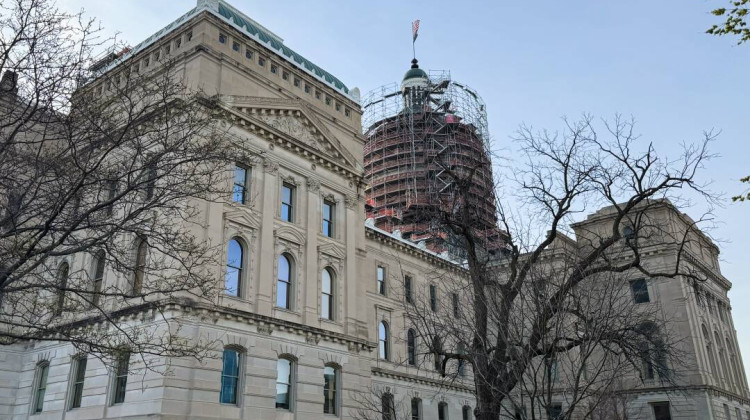
Montgomery County’s first-ever comprehensive plan, passed earlier this year, outlines a list of desired land uses in the county, as well as what the residents would like to keep out. On that second list? Low-income housing.
TAYLOR HAGGERTY / WBAA NEWSMontgomery County’s first-ever comprehensive plan, passed earlier this year, outlines a list of desired land uses in the county, as well as what the residents would like to keep out. On that second list? Low-income housing.
Crawfordsville sits at the heart of the county’s housing debate, and city officials complain the market is oversaturated with subsidized and low-income units. But oversaturation is difficult to define.
Mayor Todd Barton has been critical of subsidized housing in his city and says he believes there’s too much.
“We’re going to spend all this tax money to put people in these properties, they should be safe, they should be – and they’re not,” he says.
So he asked the Indianapolis Field Office of the Department of Housing and Urban Development to do formal inspections. HUD officials confirm they sent inspectors to four units in Crawfordsville in May, all of which Barton says had passed inspections by the local housing authority in the past year. All four units failed HUD’s walk-through.
“There was no way in my mind that those units were meeting what they were supposed to meet,” Barton says.
The housing authority then issued letters of deficiency to the landlord saying the issues had to be resolved within 30 days.
James Cunningham is the director of HUD’s Chicago office. He says it’s common to assume low-income housing is rundown and poorly maintained. But he says the key to countering that is ensuring units meet HUD’s requirement to be decent, safe and sanitary – and that’s done through inspections.
“If you guarantee that, then you can alleviate some misconceptions that all the rundown housing is low-income housing,” Cunningham says. “But I think you also need to take a look and see if that actually is the case in your community.”
Crawfordsville Housing Authority Director Debra Hole says they’ve decided to train their inspectors and have them certified to perform the same inspections HUD does.
But those four units don’t account for even one percent of the nearly 500 low-income vouchers from the CHA. Hole says her organization covers the entire county. Barton says it only extends a few miles outside the city. The difference is key to his argument that there’s too much subsidized housing per capita.
WBAA contacted about 30 Indiana cities similar to Crawfordsville in either size or location, and many couldn’t provide housing data. Ten cities did send data, though (see map, at right).
If vouchers can only be used in Crawfordsville, it has about 31 units per 1,000 people – the highest rate of any of the ten. But if the whole county can get them, that number drops to 13 of every 1,000 residents, and puts Crawfordsville middle of the pack. A request to receive the CHA’s bylaws went unfulfilled, and they’re not on the city’s website.
Sociologist and Purdue University College of Liberal Arts Dean David Reingold says Indiana has a “patchwork” system for subsidized housing. There’s a combination of federally-subsidized complexes, and state or local housing authority vouchers that cover a portion of the tenant’s rent anywhere a landlord agrees to participate.
He says because of that, it’s hard to track data, and it’s difficult to determine what constitutes oversaturation. He says most research on low-income housing looks at metropolitan areas like Chicago – and it’s hard to translate that to rural Indiana.
“There’s no clear evidence where we sort of know that ratios become problematic,” Reingold says. “There’s a lot of other factors.”
One of those other factors? Management.
Barton says Crawfordsville’s local housing authority has not been transparent about its work in the past. As mayor, he appoints all but one member of the Board of Directors, and he’s changed the lineup as terms have run out.
CHA Director Debra Hole initially agreed to an interview, but when the day of the interview came, she said the Board of Directors had voted not to allow it.
WBAA reached out to three members of the Housing Authority board multiple times for an interview. They declined. A visit by WBAA reporters to the Authority’s July public meeting last week resulted in the board cancelling the meeting just minutes before it was to start.
“I’m sorry that you’re perceiving this as an adversarial relationship with the mayor and the housing authority,” Board member Meegan Reidy said after the cancellation. “I think that’s unfortunate.”
Reingold says combatting perceptions is a key part of improving subsidized housing.
“I think a lot of times it depends on the individual circumstances as to whether those are actually real or perceived,” Reingold says. “But in many cases, even if something is perceived to be real, it’s real in its consequences.”
He says low-income housing sees benefits from neighborhood associations, community outreach and collaboration.
“Low-income housing advocates need to be very in tune to and to work very hard on not dismissing those concerns but really deliberately work with individuals to mediate them,” Reingold says.
Those concerns are clear in Montgomery County: the county’s comprehensive plan, published earlier this year, lists low-income housing as an “undesirable land use” – alongside hazards like landfills and industrial waste sites.
Chris Hamm is a senior planner at HWC Engineering and project manager for the Montgomery County comprehensive plan. He says the list was created using feedback from public forums held while the plan was being developed.
“The strong sentiment in Montgomery County to ensure that long-term property rights and long-term property values are maintained and enhanced moving forward, which I think is a goal of just about anywhere,” Hamm says.
Barton says while low-income housing isn’t mentioned in the Crawfordsville plan, he’s not surprised it’s in the county plan.
“I have no doubt that people said this is something we don’t want more of. It’s a topic here,” Barton says.
The comprehensive plan was developed in part using grant funding from the Office of Community and Rural Affairs. To receive the grant, the county had to undergo an income study to estimate the number of low- to moderate-income households. That study determined roughly 56 percent of households fall in that bracket.
Residents voiced concerns at public meetings over an alleged requirement within the grant that the county create more low-income housing. OCRA says there is no such requirement. And it isn’t mentioned in the county’s application or the grant paperwork on OCRA’s site.
“There are no things like that attached with these funds. The only real requirement is that they complete the plan,” says Eric Ogle, director of OCRA’s Community Development Block Grants program.
Hamm says the plan is meant to be a snapshot of the community’s goals. He says it’s a living document that can change over time.
“It articulates the community’s vision, it states hopefully pretty clearly what the goals and objectives of the community are,” Hamm says. “And then it begins to identify those action steps and strategies as to how best, given the best available information today, the community can begin to work to achieve that vision.”
So while low-income housing is seen as an undesirable land use right now, there’s no requirement to keep it in the comprehensive plan if things change.
It’s unclear whether Crawfordsville is oversaturated with low-income housing, and while four units didn’t meet HUD’s criteria, there are hundreds more that haven’t been reviewed. Everyone agrees the inspection procedures need improvement; and experts say better inspections can lead to less stigma from a community.
More than half of Montgomery County households qualify as low-to-moderate income, and those who manage the programs say there’s a need for subsidized housing. So rather than eliminating those units, the city is likely to spend more time grappling with how to regulate them and the landlords who own them.
 DONATE
DONATE







 Support WFYI. We can't do it without you.
Support WFYI. We can't do it without you.